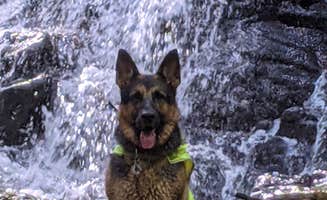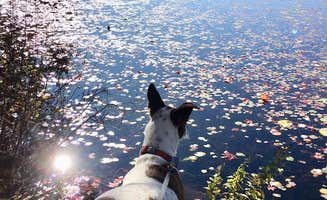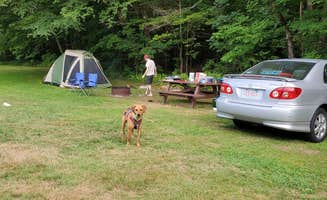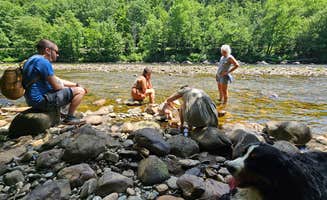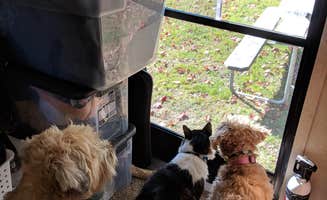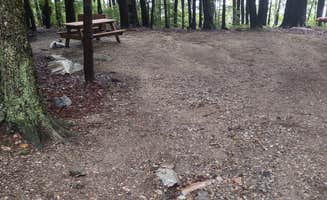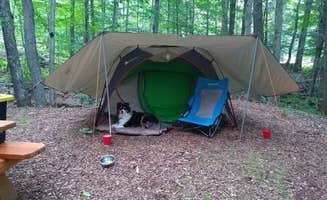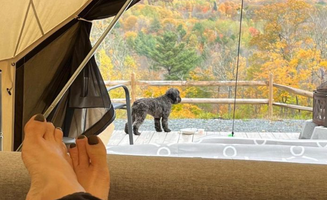Mount Greylock State Reservation offers camping opportunities from 1,300 to 3,491 feet elevation in the Berkshires region of Massachusetts. The area contains New England's only true spruce-fir forest south of Maine, with average summer temperatures ranging 7-10 degrees cooler than surrounding lowlands. Winter camping access requires snowmobiles or skis at several campgrounds in the Cheshire vicinity.
What to do
Hike the Appalachian Trail sections: The area surrounding Mount Greylock State Reservation provides direct trail access from campsites. "The hike up to the summit wasn't too far from the camp sites, probably took us about a half hour at a brisk pace. Great place to check out," notes Kristin J. Trails vary from beginner-friendly to challenging ascents with elevation changes of 2,000+ feet.
Visit local waterfalls: Savoy Mountain State Forest features multiple waterfall hikes accessible from camping areas. "There are a number of nearby waterfalls a short hike from the campground. Trails also leave here and head to the summit of Greylock or to the Stony Ledge Overlook," explains Jean C. Tannery Falls, located 20 minutes from Savoy Mountain State Forest Campground, offers a 100-foot cascade through a rocky ravine.
Experience cold water recreation: Several campgrounds feature swimming and paddling options. "North Pond was a very peaceful area to enjoy while we stayed at Savoy," reports Brian T. Cherry Plain State Park offers kayaking opportunities with on-site boat launches. Water temperatures remain cool throughout summer, rarely exceeding 72°F even during July.
What campers like
Privacy between sites: Many campers appreciate the separation between camping areas at Fernwood Forest Campground. "Large sites with trees give lots of privacy. Very clean sites and facilities are cleaned to meet COVID requirements. Very quiet," says Rebecca B. Sites at the periphery of campgrounds typically offer more seclusion than central locations.
Clean bathroom facilities: Multiple dog-friendly campgrounds maintain exceptional standards for restrooms. "The bathrooms and showers were phenomenal. A treat at the end of the day to take a shower before crawling in," shares Tiff H. about Pittsfield State Forest Campground. Some sites feature dishwashing stations outside restroom buildings for convenient cleanup after meals.
Bear-aware preparations: Campgrounds throughout the region provide bear boxes for safe food storage. "Sites are large and generally secluded, each offering a bear box set apart from the campsite itself as black bears live in the park," notes Jean C. Black bear sightings occur periodically at campgrounds around Cheshire, with increased activity during early morning and evening hours.
What you should know
Noise considerations: Some campgrounds experience unexpected noise issues. At October Mountain State Forest Campground, "There is a station nearby that offers a constant hum and during the week there are trucks going in and out of before 7am. The closer to the street side the worse it is," reports Desiree M. Selecting sites farther from roads or utility infrastructure minimizes disturbances.
Navigation challenges: GPS directions frequently lead to incorrect or difficult routes. "This campground is a very nice state park camp, but don't rely on GPS to get you there—it will put you on the wrong end of the park in the middle of a rural neighborhood," warns Bill K. Most campgrounds recommend following written directions from their websites rather than electronic navigation.
Seasonal considerations: Most campgrounds near Cheshire operate from mid-May through mid-October. "The park is so hard to find that not even a cell signal can get there, if you're looking to unplug this is a great spot," shares Bill K. Winter camping opportunities exist at select locations but require special preparation and sometimes advance permits.
Tips for camping with families
Pond swimming options: Family-friendly water access varies between campgrounds. "The pond and the hiking trail around it are beautiful," says Jay T. about Clarksburg State Park. Several campgrounds feature designated swimming areas with gradual entry points suitable for younger children, though no lifeguards are present at any locations.
Campground programming: Weekend activities provide entertainment for children at Historic Valley Campground. "Rangers provided programming for kids and families on the weekends," explains Kaileigh K. Educational presentations about local wildlife, guided nature walks, and evening campfire programs typically run from Memorial Day through Labor Day.
Site selection for children: When camping with kids, site location matters significantly. "The sites were close to each other but enough vegetation around to have a little privacy," notes Lourdes about Pittsfield State Forest. Corner sites generally provide more play space and buffer from neighboring campers, while sites closer to bathrooms reduce nighttime walking distances.
Tips from RVers
Hookup placement challenges: RVers report inconsistent utility positioning at dog-friendly campgrounds near Cheshire. "One issue is the hookups are spread out on your sites. So you may need extra hose or longer cord to complete your hookups," advises Stephen R. Most campgrounds recommend bringing at least 25-foot water hoses and 30-foot electrical cords to reach connections comfortably.
Driving routes for larger rigs: RVers should follow specific approach routes to campgrounds. "It is important to follow the directions and turn off of Rt. 2 onto Central Shaft Road. The other road that accesses the campground is nearly unpassable with an RV," cautions Heather C. about Cherry Plain State Park Campground. Most area campgrounds have narrow access roads with sharp turns unsuitable for rigs over 30 feet.
Limited cell service: Most RV campers find connectivity challenging throughout the region. "We camped during the summer of 2020 and due to covid they were only at partial capacity. This was great for us because we had a lot more privacy than we otherwise would," notes Drew Q. Verizon provides the most reliable, though still limited, coverage in the area, with service available primarily at higher elevations.


